化学实验室
威廉F号. Walsh Science Center includes general and organic chemistry labs. Walsh G09是一个普通的化学实验室, functions as a freshman's entry point into the fundamental chemical theory of CHEM 101, CHML 101, 化学102, & CHML 102. 有机化学实验室, 沃尔什G10, provides space so that each student in CHML 301 and CHML 302 can work in a fume hood and perform organic reactions with complete safety.
研究实验室
The 化学 Department 研究 Lab is designed solely for students to perform new and exciting research chemistry with faculty advisors from our department. Located in De La Roche 314, the 研究 Lab is down the hall from the 化学 Suite. 它最近被重新装修了新的引擎盖空间, 研究区域/部门, air-sensitive equipment as well as standard chemistry research equipment.
研究实验室 is located next to our 核磁共振波谱仪 (NMR), 傅立叶变换红外光谱, 液相色谱-质谱联用仪, 气相色谱-质谱仪(GC-MS), 紫外可见, 电感耦合等离子体质谱计(ICP-MS), 创造一个无缝的研究体验. (有关这些仪器的信息,见下文.)
化学系有各种各样的仪器. 他们住在De La Roche 315, next door to the 化学 研究 Lab and down the hall from the 化学 Suite.
核磁共振波谱仪
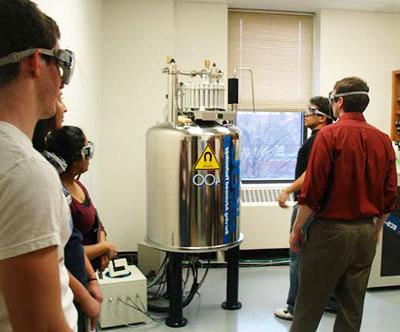 The largest of the new instruments is a 核磁共振波谱仪. The instrument, which everyone refers to as the "NMR", is a JEOL ECS 400.
The largest of the new instruments is a 核磁共振波谱仪. The instrument, which everyone refers to as the "NMR", is a JEOL ECS 400.
核磁共振通常用于确定化学结构, 了解化学和酶动力学, 测定蛋白质结构, 还有很多其他的化学物质, 物理, 以及生物应用. It is the standard tool for chemical characterization in industry, academics, and government.
An NMR works on the same principles as MRI (magnetic resonance imaging) through exciting atoms to understand their unique environment. 光谱仪是一个复杂的系统, 其核心是, utilizes a superconducting magnet kept at -459 degrees F through cooling with liquid helium and liquid nitrogen. Our 400 MHz high field NMR is ahead of research standards (for now), has automation power to run countless experiments on 24 different samples in succession, and uses a revolutionary software called Delta which is user-friendly even for beginners.
对于圣. Bonaventure, training on the NMR begins as a sophomore in Organic 化学 I (CHEM 301 & CHML 301). In the photo above, Organic 化学 students are instructed on the use of the NMR. After training, students use the instrument themselves, at times without direct supervision. Extensive use of the NMR continues in Physical 化学 II (CHEM 402 & CHML 402)以及仪器分析(CHEM 431 & CHML 431). It also finds frequent use in the ongoing research by the 化学 Department faculty.
多模四核xeon服务器计算机
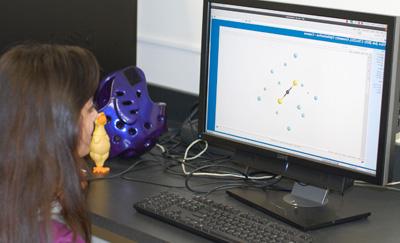 This computer cluster is equipped with Spartan Computational Modeling Software to perform various types of computational chemistry such as molecular mechanics, 半经验, 从头开始, 以及密度泛函理论计算.
This computer cluster is equipped with Spartan Computational Modeling Software to perform various types of computational chemistry such as molecular mechanics, 半经验, 从头开始, 以及密度泛函理论计算.
Computational chemistry is a growing field of theoretical chemistry that has a variety of applications such as “docking” of potential drugs into enzyme active sites.
In the photo, a student runs a computation as part of her mentored research.
手套箱
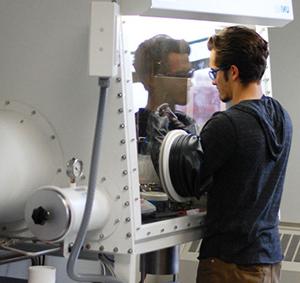 Our MBraun Unilab 手套箱 was installed in 2012 and allows for our faculty and student researchers to work in atmospheres free of oxygen for highly unstable materials and complexes.
Our MBraun Unilab 手套箱 was installed in 2012 and allows for our faculty and student researchers to work in atmospheres free of oxygen for highly unstable materials and complexes.
The glove box has been utilized in research with metal complexes.
In the photo to the right, a student works in the 手套箱 preparing for an upcoming reaction.
荧光计
The Olis ArcOptix fluorimeter measures the fluorescence emissions of given substances and chemical compounds at seven different wavelengths.
当分子被光激发时, sometimes the molecule will emit a different wavelength of light. This is fluorescence and a fluorimeter can quantify this light emission. 应用于医学、生物化学和法医学.
拉曼分光光度计
用DeltaNu拉曼光谱仪观测振动, 旋转, and other low frequency modes of excitation and is complementary to our infrared spectrometer. Raman is commonly used for analysis of crystals to determine morphology and packing. It is also used in the monitoring of anesthetics during surgery and in the field of nanotechnology for analyzing nanostructures such as nanocrystals, 纳米管, 和石墨烯.
FT-红外分光光度计
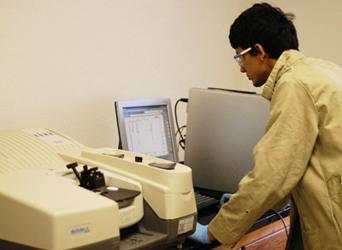 Our Nicolet Nexus 670 傅立叶变换红外光谱 allows us to excite specific chemical bonds to determine structure or identify compounds by their characteristic IR “fingerprint”. Our instrument also allows for ATR sampling which results in very simple sample preparation.
Our Nicolet Nexus 670 傅立叶变换红外光谱 allows us to excite specific chemical bonds to determine structure or identify compounds by their characteristic IR “fingerprint”. Our instrument also allows for ATR sampling which results in very simple sample preparation.
Students can expect to work on this instrument by their sophomore year. 它常用于制造业的质量控制, 在塑料分析中, 在法医学中, 比如测量血液中的酒精含量.
在右边的照片中,一名学生正在运行红外光谱样本.
液相色谱质谱计
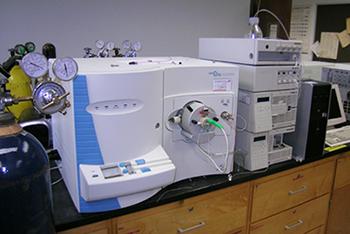 The 液相色谱质谱计 is a powerful instrument that combines the 物理 separation capabilities of high performance liquid chromatography (HPLC) with the mass analysis capabilities of mass spectrometry.
The 液相色谱质谱计 is a powerful instrument that combines the 物理 separation capabilities of high performance liquid chromatography (HPLC) with the mass analysis capabilities of mass spectrometry.
The LC-MS is standard equipment in the pharmaceutical and chemical industry. 这对质量控制很重要, 药物开发, as well as testing the pharmacokinetics of drugs to see how quickly it is cleared from the body. 它也被广泛应用于蛋白质组学, the follow-up field of study to the sequencing of the human genome.
气相色谱质谱计
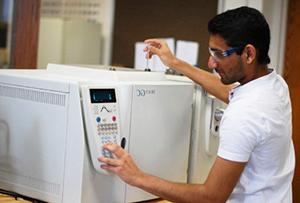 液相色谱质谱计, 上面描述的, complements our previously-obtained 气相色谱质谱计.
液相色谱质谱计, 上面描述的, complements our previously-obtained 气相色谱质谱计.
The GC-MS is very important in identifying substances in environmental chemistry, 取证, astro-chemistry, 食品分析, 和医学.
图为一名学生在气相色谱-质谱仪上测试样品.
紫外可见分光光度计
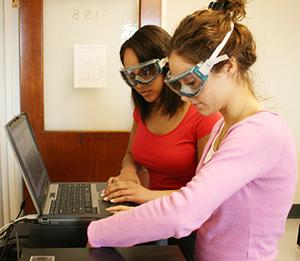 The 紫外可见分光光度计 measures the ability of molecules to absorb light photons at a particular wavelength in the ultraviolet or visible region.
The 紫外可见分光光度计 measures the ability of molecules to absorb light photons at a particular wavelength in the ultraviolet or visible region.
紫外可见光谱常用于测定金属的氧化态, 有机分子中的偶联, 以及两个或更多不同分子之间的电荷转移.
在照片中,化学专业的学生把一个样品放在紫外线-可见.